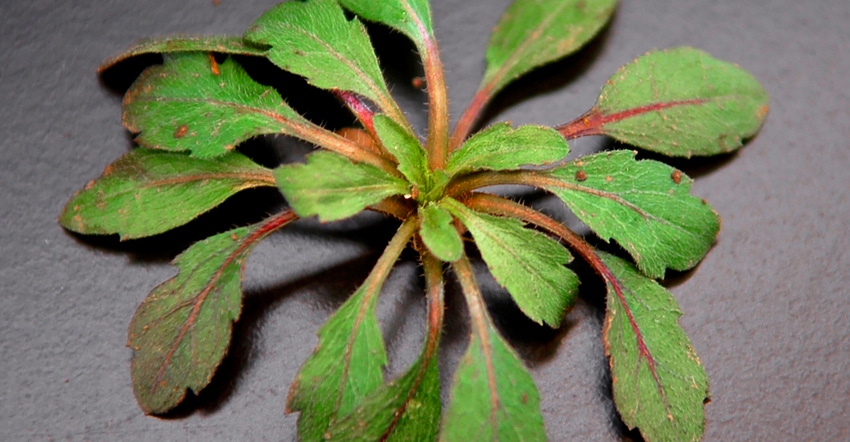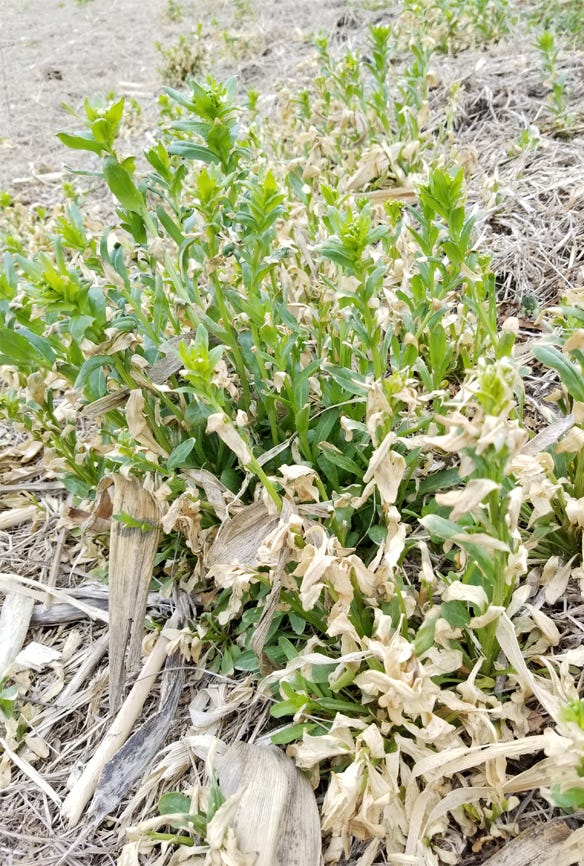June 11, 2019

With early spring flooding and continued cool, wet weather, early spring burndown or preemergence herbicide applications for control of marestail were not possible or may have been less effective than expected in many areas.
Even in fields where 2,4-D or other burndown herbicides such as paraquat were applied for control of winter annual weeds, wet, cloudy weather has reduced the efficacy of these herbicides (see photo below).
This has resulted in marestail control escapes from early burndown herbicides. Additionally, because of continuous rain, corn and soybean planting was delayed in many fields, providing an extended opportunity for marestail growth and establishment.

REDUCED EFFICACY: Even when applicators could find a suitable weather day for burndown applications, wet and cloudy conditions reduced herbicide efficacy — as was the case with this field pennycress.

Even after planting, many corn and soybean fields may have been too wet for a preemergence herbicide application. As a result, postemergence herbicides are the only option for control of marestail.
Studies show that most marestail plants emerge during fall and survive the winter by forming basal rosettes (see top photo). However, significant spring and early summer emergence also has been observed in Nebraska.
Glyphosate applied alone will not be effective for control of glyphosate-resistant marestail in glyphosate-resistant corn and soybeans. But there are several postemergence herbicide options for corn and a limited number for soybeans.
Control in corn
For postemergence control of glyphosate-resistant marestail in corn, dicamba-based herbicides and glufosinate (such as Liberty only for Liberty Link Corn) atrazine are effective options.
Control options for marestail in corn include:
• Acuron or Resicore. Acuron or Resicore can be applied early postemergence when corn is less than 12 inches tall and marestail is less than 4 inches tall. Other herbicides such as Realm Q or Capreno plus atrazine also can be considered.
• DiFlexx. DiFlexx is a formulation of dicamba with CSI safener. It can be applied at a rate of 10 to 12 fluid ounces per acre up to V10 corn. It will provide better corn safety.
• Diflexx DUO. Diflexx DUO is a premix of DiFlexx and Laudis and can provide effective control of marestail.
• Status. Status is a premix of dicamba and diflufenzopyr and can be applied to corn up to 36 inches tall or V10 stage. It may provide about 80% control, depending on the size of marestail.
• Clarity. Clarity can be applied up to 16 ounces per acre. Apply broadcast up to the five-leaf stage or 8-inch corn. Apply 8 ounces per acre or less broadcast or as a directed spray up to 36 inches tall or 15 days before tassel emergence, whichever occurs first.
• Use directed spray. Corn more than about 8 inches tall is more sensitive to dicamba, but use of a directed spray will reduce the risk of injury.
• Liberty. Liberty can be applied only to Liberty Link corn. It is a contact herbicide, so effective spray coverage is required. (Use a spray volume of a minimum 20 gallons per acre and medium-size spray droplets). Liberty can be tank-mixed with DiFlexx to improve marestail control in Liberty Link corn.
• Hornet. Hornet is a combination of clopyralid and flumetsulam. It can provide up to 80% control, depending on the size of marestail.
Control in soybeans
Effective postemergence herbicides are limited in soybeans for control of glyphosate-resistant marestail because several glyphosate-resistant marestail populations also are resistant to ALS-inhibiting herbicides such as Pursuit, Raptor, Classic and Scepter.
Control options include:
• FirstRate. If marestail is not ALS inhibitor-resistant, then FirstRate can provide about 60% to 80% control, depending on height of marestail at the time of application.
• Other possibilities. Reflex, Flexstar, Harmony SG, Marvel and Torment also may be good options.
• Liberty. If Liberty Link soybean is planted, a postemergence application of Liberty may be effective. However, Liberty can only be applied before Liberty Link soybean starts flowering. Follow application recommendations for greater efficacy.
• Dicamba formulations. New dicamba formulations (FeXapan/Engenia/XtendiMax) can be applied in dicamba-resistant (Roundup Ready 2 Xtend) soybeans. Specific nozzle and tank-mixing instructions should be followed.
• Tavium. Tavium, a new premix of dicamba and S-metolachlor, can be applied postemergence (up to V4 soybean growth stage or within 45 days after planting, whichever comes first) in Roundup Ready 2 Xtend soybean.
For other herbicide options, refer to 2019 Guide for Weed, Disease, and Insect Management in Nebraska (EC 130).
Always read the herbicide label before applying.
Field days approaching
Nebraska Extension is reminding growers of two upcoming field days.
A Weed Management Field Day, planned at the South Central Ag Lab near Clay Center, Neb., will kick off with registration at 8 a.m. June 26. Tours of projects on weed control in soybean will begin at 8:30 a.m., with a break at 10, before resuming with tours of corn and popcorn weed control projects at 10:15. A free lunch will be provided before the field day wraps up at 1 p.m.
The event is free to attend, but registration is required.
The South Central Ag Lab is located 4.5 miles west of the intersection of Highway 14 south and Highway 6, or 12.4 miles east of Hastings on Highway 6.
A Glyphosate-Resistant Palmer Amaranth Management Field Day will be July 10 near Carleton, Neb., kicking off with registration at 8:30 a.m. Tours of demonstration projects start at 9:30, followed by a presentation at 11:15 by keynote speaker Jason Norsworthy, professor and the endowed chairman of weed science at the University of Arkansas. The field day will include a free lunch before ending at 1 p.m.
The event is free to attend, but registration is required at agronomy.unl.edu/palmer.
To get to the field day from Geneva, Neb., drive south on Highway 81 for 14.6 miles, then turn west on Highway 4 and drive for 5.3 miles before arriving at the farm field on the south side of Highway 4, between C Street and Renwick Street in Carleton.
Jhala is a Nebraska Extension weed management specialist.
Source: UNL CropWatch, which is solely responsible for the information provided and is wholly owned by the source. Informa Business Media and all its subsidiaries are not responsible for any of the content contained in this information asset.
About the Author(s)
You May Also Like




